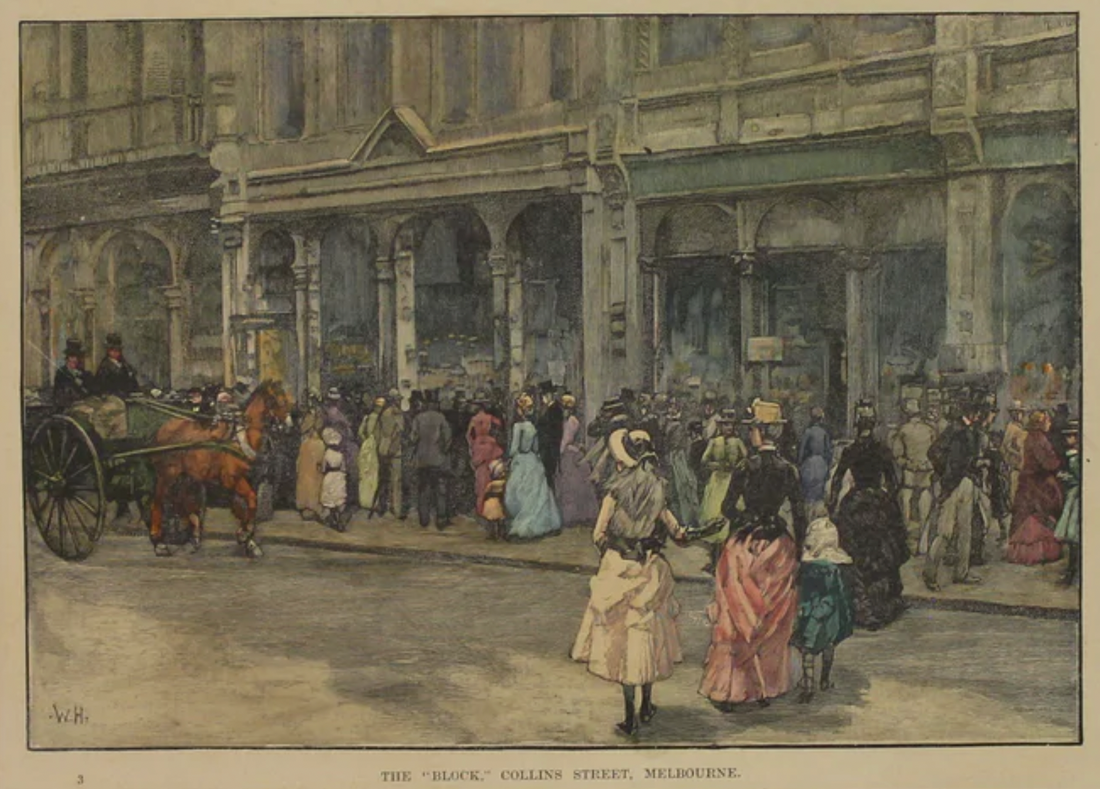Dressing Madame for Marvellous Melbourne in the 1880s
The real boom era for which Melbourne was most famous around the world was the 1880s - when the expression "Marvellous Melbourne" was coined.
A lot of people don't realise how different the fashion was over the period of the Victorian era, which spanned 1837-1901, when Queen Victoria ruled Great Britain and its Empire.
So what would a woman who had emigrated from England in the post-Gold rush era of the 1880s - likely have worn?
When I decided to run a tour of the historic "Little Lon" district of Melbourne in the Victorian era, taking in its history, archaeology, buildings and stories, I turned myself to this question.


Detail from: William Hatherell A Melbourne Gutter in Earlier Days (c1886) Hand-coloured engraving
The inspiration: A private collection 1880s bustle dress
Last year, I had a 1780s inspired attire that Governess Theresa Berkley may have worn in 1820s to recreate the era of her client's childhoods, which I wore on Sky History channel Sex: A Bonkers History appearing with UK celebrity Amanda Holden.
This year, for my 1880s history tour of Little Lon, I began researching various historical dresses from public and private collections, and decided to focus in on a silk and velvet bustle dress, featured on the blog of "Witness2Fashion". This was a dress style worn by a middle class woman, suited to using as a base starting point for the creation of my Madame Melbourne 1880s bustle dress.



Image: Private collection Bustle dress (1880s), "A memorable bustle dress" by Witness2Fashion Wordpress blog at: https://witness2fashion.wordpress.com/2014/12/18/a-memorable-bustle-dress/
Sourcing materials and buttons
Amongst popular colours of the era were burgundy wine colours, cerise, mauve and purples, so I steered Inna towards that range of hues.
A lot of buttons were needed for the bodice, and rather than going with generic mock-historic look commercial buttons, I managed to find a "lot" of 20 genuine Victorian buttons for sale, presumably salvaged from a badly damaged and disintegrating Victorian garment.
My dress maker, Inna, tracked down a silk taffeta, in Prague, and a 1 metre of a deep burgundy / purple velvet in Italy which she thought would work well for the trimming.



Above: Original Victorian black gold buttons with gold lustre design, Silk taffeta and Velvet trim fabrics.
New Canaan 1880s burgundy silk and velvet dress
I found another historical dress that had similar use of silk with velvet running down the bodice, in dark crimson and burgundy hues, of similar 1880s era in New Canaan Museum.


Original at New Canaan Museum and Historical Society: https://nchistory.org/burgundy-silk-and-velvet-dress-with-large-bow-bustle-c-1880s/
And a TikTok video of the dress being put onto a mannequin: https://www.tiktok.com/@cengel199/video/7150333858314046763
Examining some historical 1880s photographs
On Witness2Fashion's post, a commenter had mentioned her great-great grandmother having worn a similar dress in an undated photograph she had, which similarly featured vertical velvet panels on the bodice.
While a Metropolitan Museum collection tintype features a woman on the right with vertical panels on her bodice, paired with a tall headpiece and parasol, dating to around 1885.
Alice (Robinson) Hughes, family photograph, c 1888. https://www.flickr.com/photos/rbbfields/52592333191/
Artist unknown (American). Studio Portrait of Two Women Holding Folded Parasols (c 1885). Tintype; Metropolitan Museum of Art https://www.metmuseum.org/art/collection/search/283662
Mody Paryzkie 1880 Summer walking dress pattern
The use of vertical centre-panels in a darker hue on dresses appears to have been popular throughout the 1880s and particularly for "walking" / "promenade" dresses.

Mody Paryzkie 1880 Summer walking dress, pattern to the gored skirt with additional pleats and drapery https://www.pinterest.com.au/pin/449797081517003028/
1885 London walking / promenade dresses - fashion plate

Plate 3. Fig. 1. — (455). — Promenade Costume of black cashmere, trimmed with velvet. The body is pointed back and front and decorated with a velvet gilet. Overskirt well draped back and front; full skirt trimmed with two panels of velvet and crossed by a band of velvet all around the skirt. Will require 12 yards of cashmere; 3 yards of velvet; 18 buttons.
from "Observations on London Fashions," and "Description of the Plates of Costumes," in London and Paris Ladies Magazine of Fashion, Literature and Fine Arts, London: Kent & Co. Vol. 58, No 650, February 1885, p. 1-4.
Source: https://www.ggarchives.com/VintageFashions/Trends/LondonFashions-1885-02.html?expand_article=1
I particularly liked the bottom edge finish on this dress, with velvet horizontal trim around the bottom above the edging.
The mid-1880s bustle
In the mid-1880s, the fashionable style was to wear a bustle dress requiring a structured bustle underneath to give the exaggerated bottom effect.



Image: Advertisement for bustles from the 1886-7; and colour illustration at right from https://mediakron.bc.edu/fashiondecor/1880s-bustle-underpinnings; Woman's bustle from c1885, with underpinnings. From Los Angeles County Museum of Art collection M.2007.211.399.
My Madame Melbourne dress
The finished dress was sent to me in Europe, while I was over there teaching and undertaking my annual archaeology tour.
The dress fit perfectly! It requires a great deal of underpinnings - corset, bustle cage, petticoat, to get the exaggerated bottom that was characteristic of the 1880s.




Images: Replica mid-1880s bustle dress for my Madame Melbourne costume, made in silk taffeta and velvet, with Victorian black glass buttons.
What do you think? Would you be amused to see such a figure moving around Melbourne city?

Spotted in the 1880s crowd: the women in a bustle dress
As I was putting together historical images of Melbourne, for a short history I am preparing, I found within the wood engraving by Hatherwall William of "The Block" Collins Street, dating to c1887, at the centre of the busy crowd...
a woman in a dark pink hued bustle dress, depicted from behind and wearing a hat - who on second glance looks just like my "Madame Melbourne".


Wood engraving: Hatherell William “The Block” Collins Street, Melbourne (c1887)


